Aurum® Design Showcase
LEGAL TENDER - MEMORABILIA - COMMEMORATION - LICENSED BRANDING
Valaurum’s groundbreaking technology represents monetary art at its finest. Aurum® artwork features precise, full color printing elevated by the premium sheen of gold visible throughout each piece. Aurum® bills are a beautiful, unique way to showcase gold in a range of settings including historical commemoration, licensed brands, individual certificates and legal tender currency.
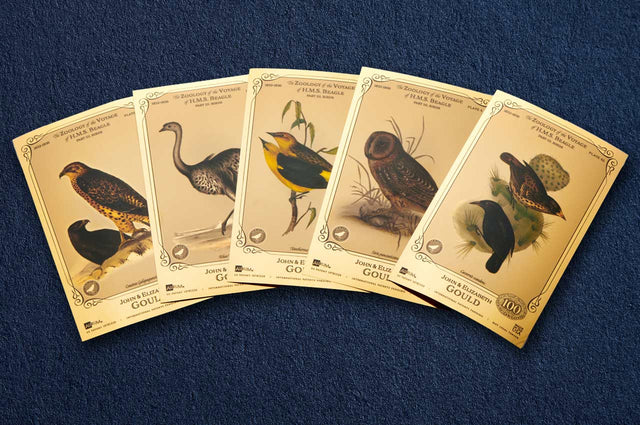
The John and Elizabeth Gould Collection - H.M.S. Beagle
2024 RELEASE
Celebrate John and Elizabeth Gould’s classic collection of bird lithographs with the H.M.S. Beagle series of Aurum® gold fine art prints. The John and Elizabeth Gould Collection – H.M.S. Beagle series includes the lithograph artwork of the Cactus Finch, Darwin’s Rhea, Galapagos Hawk, Saffron Blackbird, and the Tawny Owl. John Gould was a notable ornithologist, and his wife, Elizabeth Gould, produced beautiful, intricate illustrations to supplement his monographs. Working in concert with several lithographers, the Goulds created one of the most extensive collections of ornithological lithographs of the 1800s. John Gould worked closely with Charles Darwin to identify and categorize bird specimens collected during Darwin’s second HMS Beagle expedition to the Galapagos Islands. Gould and Darwin published their discovery of several new species unique to the islands.
The Artwork | Fine Art Prints
Each fine art print in this series showcases one of the original Gould ornithological illustrations on a background of 24 karat gold. Lightweight, durable, and collectible, these exquisite prints represent the blending of cutting-edge technology and timeless lithographic artwork. During his lifetime, John Gould published an astonishing 3,000 lithographs, many of which were designed, illustrated, and painted by Elizabeth Gould. Each lithograph plate depicts a single species shown in lifelike poses, with selected elements from their natural habitat.
The Aurum®
Aurum® gold prints are the smallest verifiable unit of gold available on the market today. Each fine art print within the John and Elizabeth Gould Collection – H.M.S. Beagle contains a precise, verifiable 100mg of 24 karat gold. A superfine layer of gold is applied to a protective, printable polymer material using patented, proprietary processes. A superfine layer of gold is applied to a protective, printable polymer material using patented, proprietary processes. The precious metal within each Aurum® is visible throughout each fine art print from edge to edge and is fully recoverable using standard fire assay techniques.
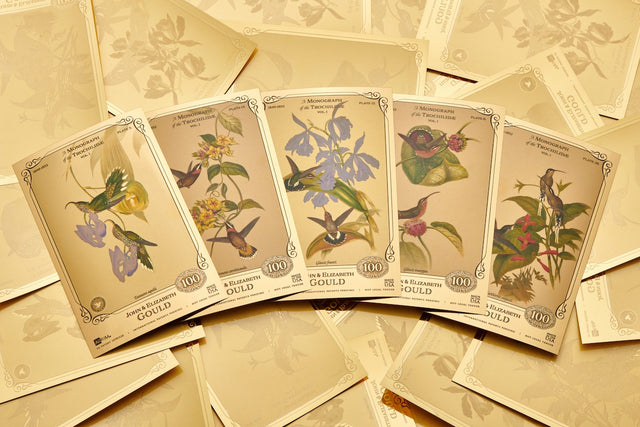
The John and Elizabeth Gould Collection - Hummingbirds
2024 RELEASE
Celebrate John and Elizabeth Gould’s classic collection of bird lithographs with the Hummingbirds collection of Aurum® gold fine art prints. The John and Elizabeth Gould Collection – Hummingbirds includes the lithograph artwork of the Fawn-Tailed, Fraser’s Hermit, Mazeppas, Salles Hermit, and Sickle Bill Hummingbirds.John Gould was a notable ornithologist, and his wife, Elizabeth Gould, produced beautiful, intricate illustrations to supplement his monographs. Working in concert with several lithographers, the Goulds created one of the most extensive collections of ornithological lithographs of the 1800s. John Gould worked closely with Charles Darwin to identify and categorize bird specimens collected during Darwin’s second HMS Beagle expedition to the Galapagos Islands. Gould and Darwin published their discovery of several new species unique to the islands.
The Artwork | Fine Art Prints
Each fine art print in the John and Elizabeth Gould Collection – Hummingbirds showcases one of the original Gould ornithological illustrations on a background of 24 karat gold. Lightweight, durable, and collectible, these exquisite prints represent the blending of cutting-edge technology and timeless lithographic artwork. During his lifetime, John Gould published an astonishing 3,000 lithographs, many of which were designed, illustrated, and painted by Elizabeth Gould. Each lithograph plate depicts a single species shown in lifelike poses, with selected elements from their natural habitat.
The Aurum®
NOTE: This is an exact copy of the section above.
Aurum® gold prints are the smallest verifiable unit of gold available on the market today. Each fine art print within the John and Elizabeth Gould Collection – Hummingbirds contains a precise, verifiable 100mg of 24 karat gold. A superfine layer of gold is applied to a protective, printable polymer material using patented, proprietary processes. A superfine layer of gold is applied to a protective, printable polymer material using patented, proprietary processes. The precious metal within each Aurum® is visible throughout each fine art print from edge to edge and is fully recoverable using standard fire assay techniques.

Gabon 1000 Franc Aurum®
LEGAL TENDER RELEASE
The Gabon 1000 Franc Aurum® Gold Bill is the first legal tender Aurum® issued by the Bank of Central African States and the République Gabonaise. This new release is the sixth legal tender issue using Valaurum’s patented, proprietary Aurum® technology. The Gabon 1000 Franc Aurum® Gold Bill showcases two-sided printing with detailed artwork of notable cultural, geographic, and natural elements. Advanced security features are embedded throughout the artwork of the bill, creating a secure and verifiable way to invest in 24 karat gold.
Advanced security features are embedded throughout the artwork of both sides of the bill for a secure and verifiable way to invest in 24 karat gold. As with all of our Aurum products, the gold is visible throughout the bill from edge to edge and is fully recoverable usingstandard fire assay techniques.
The obverse artwork highlights the majestic African forest elephant, set on a complex pattern of variable linework, which represents both the varied landscape and western oceanic edge of Gabon. Through concerted conservation efforts, Gabon has the world’s largest population of African forest elephants, estimated at 95,000 or 60-70%. The animals thrive in the country’s humid forests, where they consume leaves, tree bark, fruit, and seeds.
The coat of arms of Gabon appears on the left side of the bill, in a vertical bar containing nine “1000” security marks to represent the country’s nine provinces. A ceremonial mask of the Fang people, one of Gabon’s 40 ethnic groups, appears as a watermark on the right side of the bill. Also present are a small silhouette of Gabon and security printing in offset and color treatment. An abstract of the Sirdavidia flower, found in Gabon’s Crystal Mountains National Park, appears across the top of the bill. Additional patterns reference the boubou, a wide-sleeved robe that is decorated with intricate embroidery.
The reverse includes an aerial view of Lopé National Park and the Ogooué River in the foreground. Lopé National Park was declared a World Heritage Site in 2007. It is an ecologically complex region home to a diverse wildlife population, including the black panther, the national animal of Gabon. A larger coat of arms is featured in the top left corner of the bill. In addition to security elements, the borders incorporate traditional patterns of the Bantu peoples, comprising over 400 distinct groups throughout Africa. Nine Sirdavidia flowers on the bottom of the bill represent the nine provinces of Gabon.
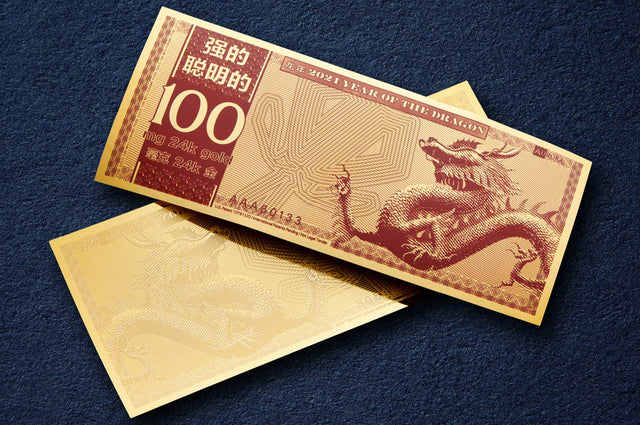
Year of the Dragon Aurum®
2023 RELEASE
Our Lunar New Year series continues with the newly issued Year of the Dragon Gold Aurum® bill for 2024. The Lunar New Year series honors the ancient Chinese lunar calendar, which dates back to the Han Dynasty (206 B.C. – 9 A.D.). 2024 is the Year of the Dragon, perhaps one of Chinese culture’s most iconic mythical creatures. The Dragon symbolizes good fortune and authority. People born in the Year of the Dragon are said to be strong, kind-hearted, and intelligent.
The artwork for the latest issue in this series depicts a mythical dragon surrounded by motifs based on traditional Chinese patterning, lanterns, and abstract elements. The bill also features a bleeding heart flower, considered lucky for people born in the Year of the Dragon. Details are captured in vibrant red, traditionally representing luck, joy, vitality, and celebration. The Chinese words for strong and intelligent are positioned within the banner in the top left corner of the bill.
The gold within each Year of the Dragon Aurum® bill is visible throughout from edge to edge and is fully recoverable using standard fire assay techniques. This Aurum® is a single-sided printed piece with the characteristic “dimensional gold” embossed effect on the bill’s reverse side where gold atoms have fallen on printed areas.
Learn more about the “dimensional gold” with our Aurum®.
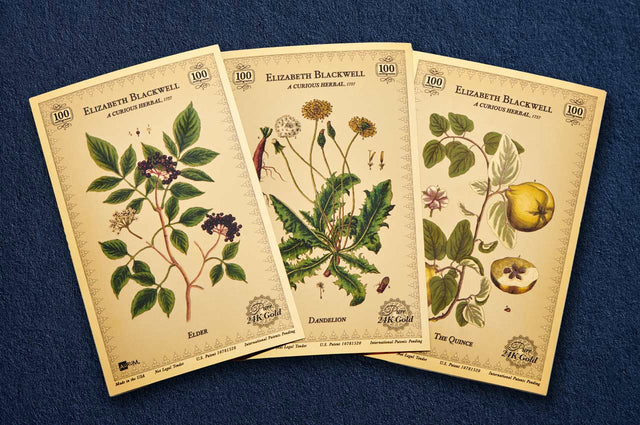
Elizabeth Blackwell BotanicalArtists Series Aurum® Set
2023 RELEASE
In the Blackwell Series, we honor pioneering botanical artist Elizabeth Blackwell with this gorgeous curated collection of her engravings of medicinal plants. Blackwell, recognized as the first British female herbalist, methodically produced her hand-drawn, etched, and engraved, hand-colored illustrations forA Curious Herbal, which was published in installments from 1737 to 1739. The artist published four plates and a page of text per week, totaling 500 meticulous illustrations. The complete work was published in two volumes, titled A Curious Herbal containing five hundred cuts of the most useful plants, which are now used in the practice of physick, to which is added a short description of ye plants and their common uses in physick.
A book of plants, known as a herbal, describes their appearance, healing properties, and instructions for preparing medicines. The earliest records of plants used for medicinal purposes date back 5,000 years from Egypt and China. Discorides, a Greek physician, wrote De materia medica in AD 65, which was the principal record of medicinal plants until the end of the 17th century.
The Merian Botanical Artists Series Set features her artwork of the Elder Plant, Quince, and Dandelion.
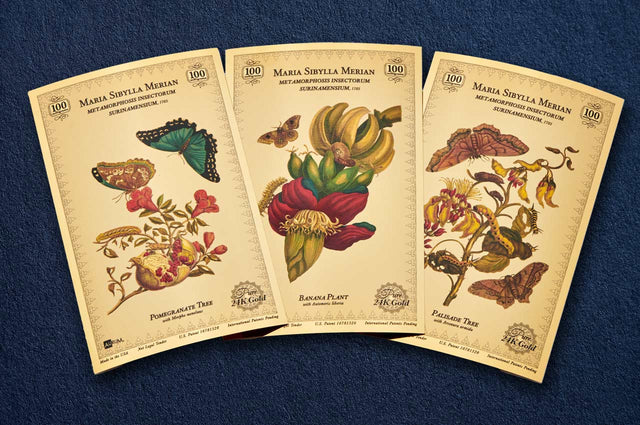
Maria Sibylla Merian BotanicalArtists Series Aurum® Set
2023 RELEASE
Celebrate the extraordinary naturalist, explorer, and scientific artist Maria Sibylla Merian with this collection of illustrations from her groundbreaking studies of exotic plants and insects. Merian’s renderings are not only impeccable in their scientific clarity, but through her observations, she contradicted the commonly held ideas of the day that insects developed through spontaneous generation.
Credited as the first person to record the process of metamorphosis in insects, Maria Sibylla Merian is recognized as one of the most influential scientists of the Enlightenment. Her method of classification for butterflies and moths is used today.
Each fine art print in this series showcases the extraordinary artistic skill of the original Merian scientific illustrations on a background of 24 karat gold. Lightweight, durable, and collectible, these exquisite fine art prints represent the blending of cutting-edge technology and timeless lithographic artwork.
The Merian Botanical Artists Series Set features her stunning artwork of the Banana Plant, The Pomegranate Tree, and the Palisade Tree.

Tanzania 1000 Shilling Kituo Cha Kigoma Aurum®
LEGAL TENDER RELEASE
The 1000 shilling Kituo Cha Kigoma Aurum® is one of two legal tender gold bills authorized for issuance by the Bank of Tanzania. This two-sided bill celebrates the unique cultures of both Tanzania (obverse artwork) and Zanzibar (reverse artwork) while incorporating the element of water throughout the bill’s design.
The new Tanzanian bill showcases two-sided printing with detailed artwork, including notable cultural, geographical, and natural elements. Advanced security features are embedded throughout the artwork on both sides of the bill for a secure and verifiable way to invest in 24 karat gold.
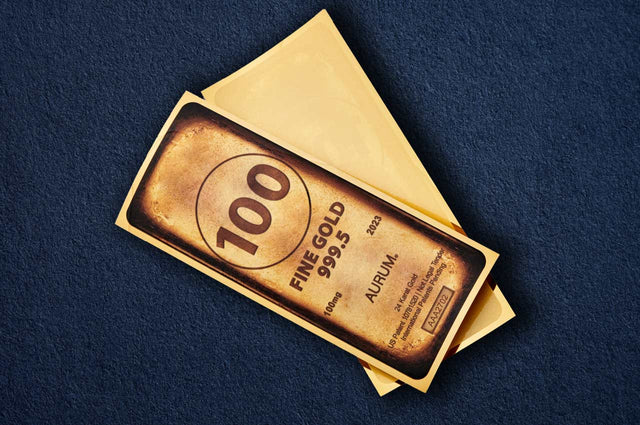
2023 Edition - 100 milligram Gold Bar Aurum®
2023 RELEASE
The 2023 edition of our popular 100 milligram Gold Bar Aurum® is a commemorative design paying homage to historical gold bars. The Aurum® is a convenient and modern way to collect and invest in 24 karat gold. Designed to be stacked or collected in bulk, this Aurum® is a timeless addition to any portfolio.
This issue pays homage to traditional gold bars. A large central “100” appears on the center of each bar above the words “Aurum,” which is the Latin word for gold. At the bottom of each bill, the year of issue and weight are printed, followed by a unique serial number.
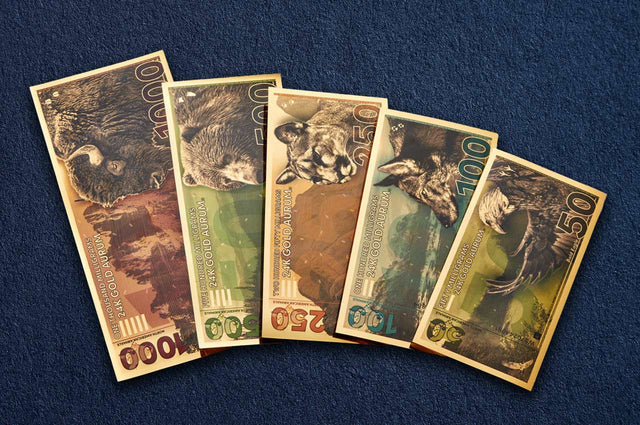
2023 Edition - North American Animal Series
CUSTOMER FAVORITE
Our 2023 Edition of the North American Animal Aurum® series features five gold bills with weights ranging from 50 milligrams to 1,000 milligrams of pure 24 karat gold. The largest bill in the series features the majestic American Bison, the largest animal in North America. The full series includes the American Bison (1,000mg), Brown Bear (500mg), Mountain Lion (250mg), Gray Wolf (100mg), and Bald Eagle (50mg). Designed to be the most flexible way to invest using fractional gold, this series offers investors a selection of denominations for customizing investment.
Showcasing some of the most iconic wildlife native to the North American continent, the amount of gold within each bill corresponds to the size of the animal depicted. Each bill beautifully presents the animal in its native landscape, integrating multiple levels of micro-printing and security elements embedded throughout the artwork for an investment that is both secure and timeless.
Each Aurum contains a precise and verifiable amount of 24 karat gold. Visible running edge-to-edge, the layer of precious metal is protected between layers of durable polymer for a high-quality, collectible product.

North American Game Fish
2023 RELEASE
Our North American Game, Fish Aurum® series, features five gold bills, all consisting of 100 milligrams of pure 24 karat gold. The bills feature five popular species of freshwater, saltwater, and Great Lakes game fish from North America. The game fish featured in this set are the Largemouth Bass, Arctic Grayling, Rainbow Trout, Sockeye Salmon, and Rock Sturgeon. These bills are designed to be the most flexible way to invest using fractional gold.
Showcasing some of the most iconic game fish in North America, each bill beautifully presents the fish living and thriving in its natural habitat, integrating multiple levels of micro-printing and security elements embedded throughout the artwork for an investment that is both secure and timeless.
For each bill, the featured game fish is shown in the profile in the center of the bill. The ornate security printing pattern surrounding the fish (layered with the background image) is based on the fish’s silhouette and the frame’s inner outline. These security features are subtly incorporated within the design for a secure and verifiable gold bill. This stunning Aurum® bill contains 100 milligrams of 24 karat gold, modernizing gold investment and making it easier to collect and store precious metals than ever before. The number “100,” a reference to the gold content, is printed in both the top-left and top-right corners in addition to appearing across the bill’s background. The name badges for the series and species names are reminiscent of brass nameplates on fishing trophies.
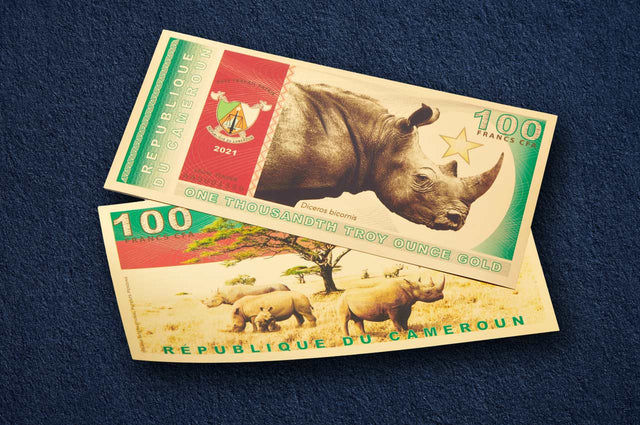
Republic of Cameroon
NEW 2021 LEGAL TENDER RELEASE
We are proud that the Republic of Cameroon selected Valaurum to manufacture its latest legal tender issue. The 100 Francs CFA Black Rhinoceros Gold Aurum® commemorates the critically endangered black rhinoceros (Diceros bicornis) in 24K gold. This is one of the first legal tender bills issued by a major government using Valaurum’s proprietary and patented Aurum® gold technology.Limited to a worldwide mintage of 10,000 pieces, Valaurum’s printing of the first 1,000 bills sold out to retailer distributors within one hour of its release.
The obverse of this issue features a single black rhinoceros (Diceros bicornis) shown in profile with a gold star and the Coat of Arms of the Republic du Cameroun. On the reverse, we see a family of black rhinoceros under an acacia tree. The red and green color palette is a reference to the Cameroonian flag.
Today, black rhinoceros are critically endangered due to poaching and black-market trafficking of rhino horn. The black rhinoceros population dropped sharply between 1960 and 1995, and at one point, as few as 2,500 survived in the wild. Conservation groups have been working tirelessly to bring this species back from the brink of extinction, and their population is slowly starting to recover.
This 24k pure gold Aurum® both celebrates and supports this rare animal. Valaurum will donate 10% of proceeds to help fund rhinoceros conservation in Africa, allowing you to invest in both your own future and the future of this incredible animal.



